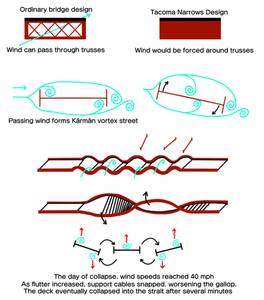Tacoma Narrows Bridge was declared open on the 1 of July 1940 in Washington State. The suspension Bridge had 853m in length, two lanes and two narrow sidewalks. At the time of its opening it was the Bridge with the third longest span in the whole world. As the Bridge had a tendency to swing up and down it very quickly became a attraction. But on November 7 of the same year the Bridge collapsed because of torsional vibrations oscillation. Luckily no people died that day but sadly a cocker Spaniel, named tubby, didn’t survive this incident because he was trapped inside a car that was still on the Bridge. But what exactly caused the Bridge to collapse?

https://upload.wikimedia.org/wikipedia/commons/thumb/0/03/Tacomanarrowssimple.png/220px-Tacomanarrowssimple.png
The main reason for the collapse was an aero elastic flutter. This occurred because at the Tacoma narrows Bridge it was not possible for the wind to flow trough the Bridge, only above and other. In Figure 1 you can see the differences between a usual Bridge and the Tacoma narrows Bridge. With conventional Bridges, it is possible for the wind to flow through the truss structure of the Bridge. As this was not possible at the Tacoma narrows Bridge it happened to a flow separation witch subsequently led to a Kármán vortex street.
A Kármán vortex street is a repeating pattern of vortices caused by a flow separation around blunt bodies. Another phenomenon caused by Kármán vortex streets is the singing sound suspended cables do sometimes.
After the Bridge collapsed engineers learned of their mistake an they redesigned the Bridge using triangular open trusses, stiffening struts and with that they allowed the wind to flow freely through the openings. In Comparison to the old Bridge the twisting was much less severe. The Disaster of the Tacoma narrows Bridge also led engineers to add trusses, and openings below the road decks at the Whitestone Bridge. The idea of using dynamic and modal analysis got a much bigger importance after the collapse of the Tacoma narrows Bridge. Nowadays while designing a bridge different kind of computer programs get used to test the bridge in the wind and also to analyze stresses and the structural behavior. With these programs engineers are able to prevent events like the Tacoma narrow bridge collapse and build better more durable bridges.
Sources:
- https://www.britannica.com/topic/Tacoma-Narrows-Bridge (Melissa Petruzzello/05.10.22)
- https://www.simscale.com/blog/tacoma-narrows-bridge-collapse/ (Ajay Harish/05.10.22)
- https://en.wikipedia.org/wiki/Tacoma_Narrows_Bridge_(1940) (05.10.22)
- https://www.welt.de/geschichte/article219420348/Einsturz-1940-Diese-Bruecke-brachte-echtes-Achterbahn-Feeling.html (Sven Felix Kellerhoff/05.10.22)
